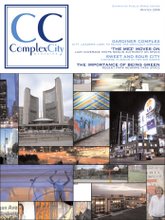Know your role
 BY SEAN BAILEY
BY SEAN BAILEY
When David Burnett thinks of the Oak Ridges Moraine, three things come to mind: Beautiful soil to produce great vegetables, plenty of plants and abundant drinking water.
Burnett is the manager of provincial regional policy at the Toronto and Region Conservation Authority (TRCA). The authority is funded in part by the city of Toronto and his job is to co-ordinate the nine conservation authorities that have watersheds on the moraine.
Toronto plays a large role in the surrounding ecosystem including the Oak Ridges Moraine. Through ever-expanding population and transport to and from the city -urban sprawl - pollutants and other waste from people damage the fragile moraine. To combat the sprawl, some urban planners suggest intensification, which makes use of undeveloped land within the city.
“Our living city policies and our new strategic plan ... promotes ... sustainable communities,” Burnett said, “which would certainly promote intensification, especially intensification that would promote transit densities.”
Susannah Bunce, a York University faculty member, is pursuing her PhD on intensification and sustainability on Toronto’s waterfront. She believes intensification can build new communities, which would be mixed-use land. This would incorporate residential, commercial and light industry.
She believes intensification can benefit both the city and environmental needs. The city would approve of intensifying its downtown core because they could make money from the increase of property taxes and in turn keep putting pressure to develop moraine lands into residential.
“It’s often considered by advocates of intensification a win-win situation,” Bunce said. “You can raise property taxes and save the environment at the same time. Since amalgamation, the city of Toronto has been cash strapped in terms of their municipal budget. A lot of their budget comes from the property tax base because of provincial cutbacks.”
Bunce points to different types of city intensification. One example is laneway housing, which makes use of space in alleyways that currently service garages.
A laneway residence can be built directly over that structure or the land can be creatively adapted to make an entirely new structure from scratch. She doesn’t believe, however, the laneway option is a cost-effective one to potential buyers.
“They’re actually quite expensive buildings because of the materials,” she said. “And because they tend to be constructed by architects who either build them for themselves or build them to sell or hire people to design to build them, they tend to have a higher overhead so they’re quite costly.”
Bunce pointed to an example in the area where she lives. Near the intersection of College and Bathurst Streets a recent laneway project was built for $400,000 and later sold for $800,000.
She says other opportunities such as in-fill housing, makes use of buildings such as former mechanic garages, townhouse complexes or low-rise condominiums, to create better, more affordable housing options.
Sonia Dong is program director of Citizens Environment Watch, a group that raises community awareness of the Oak Ridges Moraine. She agrees with the push for greater density within Toronto’s core as well.
“It would definitely increase every person’s ecological footprint,” she said. “If you were to intensify and have all the infrastructure and resources in a contained space it’s a lot better. It would also curb urban sprawl and that’s also an advantage.”
She points to examples such as low-rise apartments along the harbourfront or townhome complexes throughout suburbs such as Scarborough, on land formerly used for industrial purposes.
Dong says people who aren’t living directly in the vicinity of the moraine are uneducated when it comes to knowing what the moraine does for them.
At the CEW they go around to areas such as the GTA and educate people “to understand that the head waters of a lot of the big rivers like the Don River and the Humber River and the Rouge, they come from the Moraine,” she said.
She works to inform people about how moving out to area can damage the ecosystem if the land is not treated properly.
“We need a solid terrestrial natural heritage system which is the streams, rivers, forests and the wetlands to provide the foundation for a high quality of life within the urban Greater Toronto Area,” he said.






